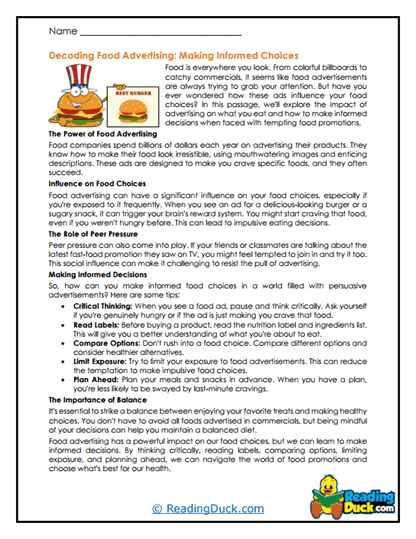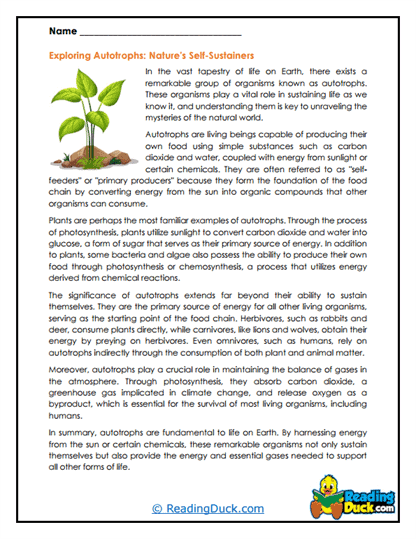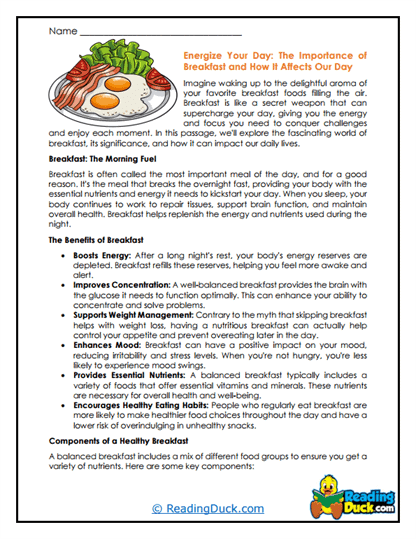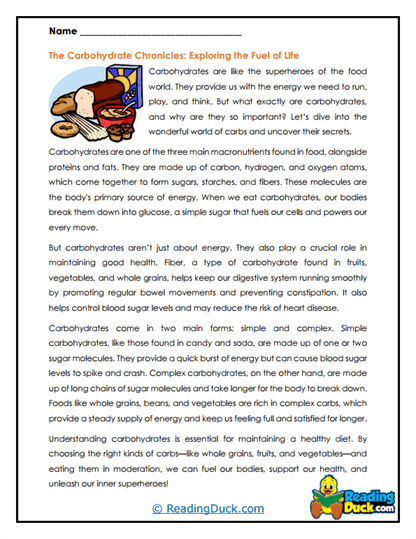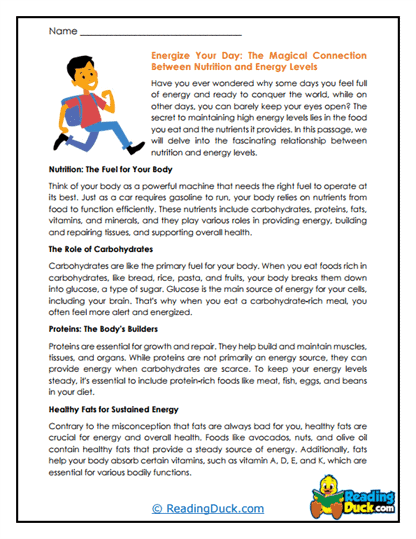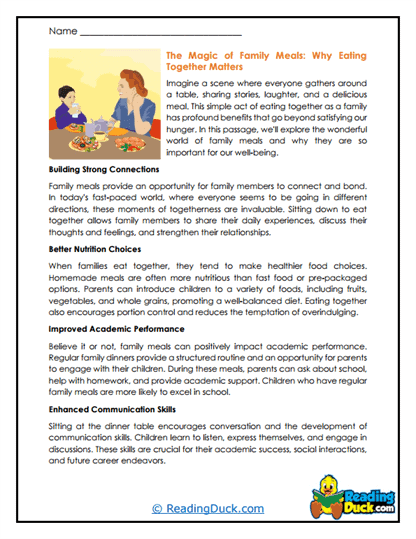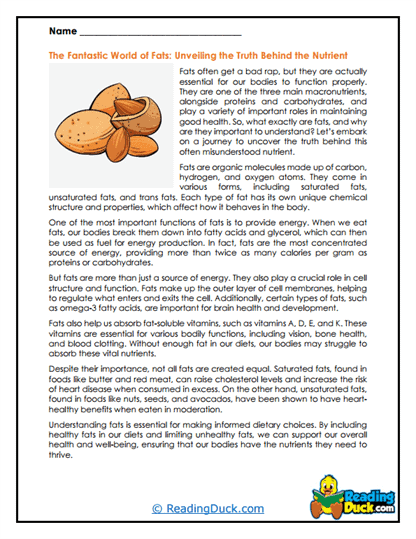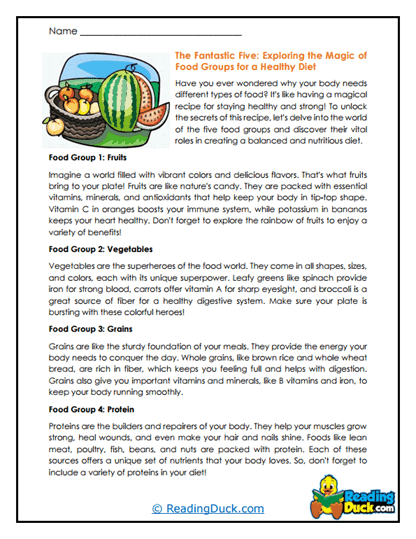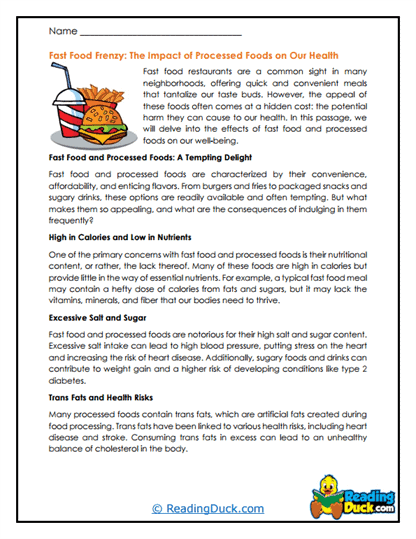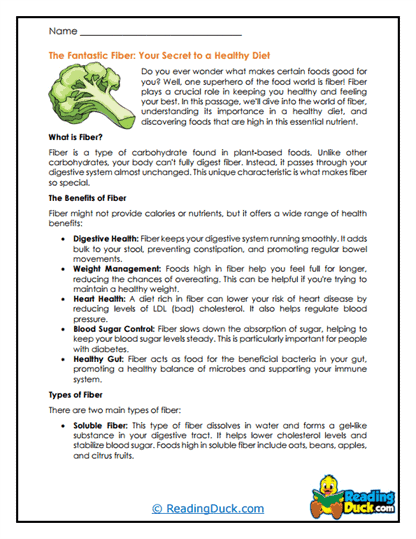Nutrition Worksheets
About Our Nutrition Worksheets
Our Nutrition Worksheets are designed to help students understand the importance of a balanced diet and the role it plays in overall health. These worksheets aim to educate students on various aspects of nutrition, providing them with the knowledge they need to make informed choices about what they eat. As part of the broader Health category, these worksheets are crucial in helping students grasp the essentials of healthy living. The Health category also includes other vital topics such as Alcohol, Eating Disorders, Exercise, Healthy Relationships, Mental Health, Peer Pressure, Personal Hygiene, Substance Abuse, and Tobacco. Each worksheet set is not just about reading—it’s about understanding critical issues that directly impact students' lives and helping them make informed, healthy choices.
This topic contains several worksheet sets, each focusing on a specific aspect of nutrition. Each worksheet set includes:
- Multiple Choice Questions: These questions assess students' comprehension of the reading passages, focusing on key concepts such as the components of a balanced diet, the nutritional value of different foods, and the impact of poor nutrition on health.
- Short Answer Questions: Students provide concise responses, summarizing important information, reflecting on their own eating habits, and analyzing the nutritional content of common foods.
- Open-Ended Questions: These questions encourage students to think critically and express their personal views, opinions, and feelings about nutrition, fostering deeper connections to the material and promoting healthy dietary choices.
These worksheets help students demonstrate their understanding of the material while encouraging them to apply these concepts to their own lives. An answer key is provided for each question sheet, making it easy for teachers and parents to assess student progress. All worksheets are available as PDF files, which can be easily viewed electronically, downloaded, and printed.
Understanding Nutrition: Building a Foundation for Healthy Living
Nutrition is a fundamental aspect of health that directly influences how our bodies function and how we feel daily. Proper nutrition is essential for maintaining energy levels, supporting growth and development, preventing chronic diseases, and promoting overall well-being. These worksheets explore various facets of nutrition, providing students with the tools they need to make informed dietary choices that support their health and wellness.
When teaching students about nutrition, it is important to cover a variety of key concepts and areas of interest:
- The Components of a Balanced Diet: A balanced diet includes a variety of foods that provide the essential nutrients our bodies need to function correctly. Students learn about the five major food groups—fruits, vegetables, grains, protein foods, and dairy—and the role each plays in a healthy diet. They explore the importance of consuming a mix of macronutrients (carbohydrates, proteins, and fats) and micronutrients (vitamins and minerals) to maintain optimal health. Understanding the components of a balanced diet helps students make healthier food choices and appreciate the importance of dietary diversity.
- Nutritional Needs at Different Life Stages: Nutritional requirements vary throughout life, depending on age, gender, activity level, and health status. Students explore the specific nutritional needs of different life stages, including childhood, adolescence, adulthood, and old age. They learn about the importance of proper nutrition during growth periods, such as childhood and adolescence, and how nutritional needs change with aging. This knowledge helps students understand the importance of adapting their diets to meet their changing needs and supports healthy growth and development.
- Understanding Food Labels: Food labels provide valuable information about the nutritional content of foods, including the amount of calories, fats, sugars, and other nutrients. Students learn how to read and interpret food labels, helping them make informed choices when selecting foods. They explore how to identify healthy options and understand the significance of serving sizes, daily value percentages, and ingredient lists. This practical skill empowers students to take control of their dietary choices and encourages mindful eating.
- The Impact of Poor Nutrition: Poor nutrition can lead to various health problems, including obesity, heart disease, diabetes, and malnutrition. Students explore the consequences of an unbalanced diet, such as the long-term effects of consuming too much sugar, salt, or unhealthy fats. They also learn about the risks associated with nutrient deficiencies, such as iron deficiency anemia or vitamin D deficiency. Understanding the impact of poor nutrition motivates students to prioritize healthy eating and make dietary choices that support their overall health.
- The Role of Hydration in Nutrition: Hydration is a critical aspect of nutrition that is often overlooked. Students learn about the importance of drinking enough water daily and how proper hydration supports bodily functions such as digestion, circulation, and temperature regulation. They explore the signs of dehydration and the role of other beverages, such as milk and juices, in maintaining hydration. Understanding the role of hydration helps students develop habits that support their overall health and well-being.
- Cultural Influences on Diet: Cultural background and traditions play a significant role in shaping dietary habits and food choices. Students explore how different cultures approach food and nutrition, from traditional cuisines to dietary practices associated with religious or cultural beliefs. They learn to appreciate the diversity of diets around the world and understand how cultural influences can impact their eating habits. This awareness fosters a greater appreciation for global food cultures and encourages students to make informed and respectful dietary choices.
- Healthy Eating on a Budget: Eating a balanced diet doesn’t have to be expensive. Students learn practical strategies for making healthy food choices on a budget, such as planning meals, buying in-season produce, and choosing cost-effective protein sources. They explore how to prioritize nutrient-dense foods and avoid processed and sugary foods that offer little nutritional value. Understanding how to eat healthily on a budget helps students make practical and sustainable dietary choices.
- The Connection Between Nutrition and Mental Health: Nutrition doesn’t just affect physical health; it also plays a significant role in mental well-being. Students explore the link between diet and mental health, learning how certain nutrients can affect mood, energy levels, and cognitive function. They examine the impact of sugar, caffeine, and other dietary factors on mental health and learn about the benefits of a balanced diet rich in whole foods for supporting emotional well-being. This understanding encourages students to view nutrition as an integral part of their overall health.
Through these topics, students gain a comprehensive understanding of nutrition and its importance in maintaining both physical and mental health. They learn to appreciate the role of a balanced diet in their overall well-being and develop the skills needed to make informed dietary choices.
The Significance of Raising Awareness
Raising awareness about nutrition is crucial, especially as students develop habits that will carry into adulthood. Understanding nutrition equips students with the knowledge they need to make informed choices about their diets, which can significantly impact their long-term health. Early education on this topic can prevent diet-related chronic diseases, support healthy growth and development, and promote a balanced approach to eating that includes a variety of foods.
Proficiency in this topic benefits students in several ways. Academically, it enhances their ability to concentrate, focus, and perform well in school by supporting their physical and mental health. Personally, it fosters a sense of responsibility for their well-being and encourages lifelong habits that promote health and vitality. Moreover, it equips students with the knowledge and skills needed to navigate a world full of dietary choices, helping them make decisions that align with their health goals and values.
How To Use These Worksheets
These Nutrition worksheets can be effectively integrated into various subjects and classes, particularly in health education, science, and family and consumer sciences courses. For middle school students, these worksheets introduce the basics of nutrition, helping them understand the importance of a balanced diet and how to make healthy food choices. For high school students, the worksheets can be used to explore more complex topics such as reading food labels, understanding nutritional needs at different life stages, and analyzing the impact of diet on physical and mental health. Teachers can also incorporate these worksheets into broader discussions on health and wellness, providing a holistic approach to education that emphasizes the importance of nutrition.
Incorporating these worksheets into the curriculum not only reinforces key health principles but also helps students develop essential life skills such as meal planning, budgeting, and mindful eating. By engaging with real-world scenarios and questions that require them to apply their knowledge, students build a strong foundation in nutritional literacy that will serve them well throughout their lives.
Overall, the Nutrition Worksheets provide a comprehensive and engaging way for students to explore the importance of healthy eating, gain a deeper understanding of its impact on their overall health, and develop the skills they need to maintain a balanced and nutritious diet.
